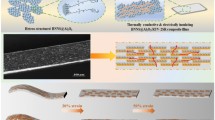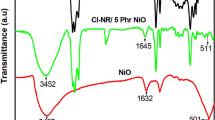Abstract
Conducting polymer film has been found to be good alternative for conventional metal film in the application of flexible conductors for stretchable electronics. This research aims to produce green conductive polymer film with good mechanical and electrical performance through incorporation of polyaniline (PAni) as conductive material and carboxymethyl cellulose (CMC) as natural reinforcing filler in grafted rubber host. Different molar ratios of aniline (Ani) monomer and docusate sodium salt purum (AOT) dopant were used to produce PAni:AOT of molar ratio 5:3, 5:5 and 5:7. Grafted rubber/PAni/CMC films were synthesised using ex situ polymerisation and characterized by FTIR, XRD and SEM analyses. The mechanical and electrical performances were studied via universal tensile machine and resistivity meter, respectively. Incorporation of PAni in polymer films improved the electrical conductivity from 0 S cm−1 (MG49/CMC) to 1.388 \(\times\) 10–7–1.807 \(\times\) 10–2 S cm−1 (MG49/PAni/CMC). Addition of CMC enhanced the mechanical performances of the films with improved tensile strength and Young modulus from 8.0 (MG49/PAni 5:7) to 9.2–12.1 MPa (MG49/PAni 5:7/CMC) and 279 MPa (MG49/PAni 5:7) to 401–630 MPa (MG49/PAni 5:7/CMC), respectively. In conclusion, mechanical performance and electrical conductivity range of the synthesized conductive polymer film of MG49/PAni 5:7/CMC fulfil the recommended mechanical and electrical performance range of traditional and commercial conductive films.








Similar content being viewed by others
References
Han JQ et al (2018) Nanocellulose-templated assembly of polyaniline in natural rubber-based hybrid elastomers toward flexible electronic conductors. Ind Crops Prod 128:94–107
Wang Y et al (2017) A high stretchable, transparent, and conductive polymer. Sci Adv 3:1–10
Rebelo AMR et al (2019) Carbon nanotube-reinforced poly(4-vinylaniline)/polyaniline bilayer-grafted bacterial cellulose for bioelectric applications. ACS Biomater Sci Eng 5:2160–2172
Ates B et al (2020) Chemistry, structures, and advanced applications of nanocomposites from biorenewable resources. Chem Reviews 120(17):9304–9362
Wang M et al (2019) Conjugated polymers and composites for stretchable organic electronics. J Mater Chem C 7:19
Zhang S et al (2017) Preparation, characterization, and electrochromic properties of nanocellulose-based polyaniline nanocomposite films. ACS Appl Mater Interfaces 9:16426–16434
Rosli NA, Ahmad I, Anuar FH, Abdullah I (2016) Mechanical and thermal properties of natural rubber-modified poly(lactic acid) compatibilized with telechelic liquid natural rubber. Polym Testing 54:196–202
Jafirin S, Ahmad I, Ahmad A (2013) Potential use of cellulose from kenaf in polymer electrolytes based on MG49 rubber composites. BioResources 8:5947
Mazzeu M et al (2018) Influence of reaction time on the structure of polyaniline synthesized on a pre-pilot scale. Braz J Chem Eng 35:123–130
Silva MJ et al (2014) Nanocomposites of natural rubber and polyaniline-modified cellulose nanofibrils. J Therm Anal Calorim 117:387–392
Sambasevam KP, Mohamad S, Phang SW (2015) Effect of dopant concentration on polyaniline for hydrazine detection. Mater Sci Semicond Process 33:24–31
Chiam YS (2014) Conducting polymer coated optical microfiber sensor for alcohol detection. Sens Actuators, A 205:58–62
Chai MN, Isa MIN (2013) The oleic acid composition effect on the carboxymethyl cellulose based biopolymer electrolyte. J Cryst Process Technol 3:1–4
Ataollahi N (2013) Ionic conduction of blend poly (vinylidene fluoride-hexafluoro propylene) and poly (methyl methacrylate)-grafted natural rubber based solid polymer electrolyte. Int J Electrochem Sci 8:7875–7884
Su’Ait MS, et al (2012) Preparation and characterization of blended solid polymer electrolyte 49wt% poly (methyl methacrylate)-grafted natural rubber: poly (methyl methacrylate)–lithium tetrafluoroborate. J Solid State Electrochem 16:2275–2282
Phang SW, Kuramoto N (2010) Microwave absorption property of polyaniline nanocomposites containing TiO2 and Fe3O4 nanoparticles after FeCl36H2O treatment. Polym Compos 31:516–523
Ji J, Li B, Zhong WH (2010) Simultaneously enhancing ionic conductivity and mechanical properties of solid polymer electrolytes via a copolymer multi-functional filler. Electrochim Acta 55:9075–9082
Chatterjee B, Kulshrestha N, Gupta P (2016) Nano composite solid polymer electrolytes based on biodegradable polymers starch and poly vinyl alcohol. Measurement 82:490–499
Jung S (2009) Fillers for solid-state polymer electrolytes: highlight. Bull Korean Chem Soc 30:2355–2361
Sudiarti T (2017) Mechanical strength and ionic conductivity of polymer electrolyte membranes prepared from cellulose acetate-lithium perchlorate. IOP Conf Ser: Mater Sci Eng 223:012052
Sari TI (2017) Modification of natural rubber as a resistant material to dimethyl ether. J Appl Sci 17:53–60
Kim SC (2006) Synthesis and properties of self-doped polyaniline with polycationic templates via biocatalysis. J Macromol Sci Part A Pure Appl Chem 43:2007–2018
Chabukswar V, Bhavsar S (2010) Synthesis and characterization of organically soluble and electrically conducting acids doped polyaniline. Ch&ChT 4:277–280
Sambasevam KP (2015) Synthesis and characterization of polyaniline for hydrazine detection. Advance Materials. Doctoral dissertation, Jabatan Kimia, Fakulti Sains, University Malaya
Ayad M, Zaki E (2008) Doping of polyaniline films with organic sulfonic acids in aqueous media and the effect of water on these doped films. Eur Polymer J 44:3741–3747
Rozik N, Khalaf A, Ward A (2016) Studies the behaviours of polyaniline on the properties of PS/PMMA blends. Pro Inst Mech Eng, Part L: J Mater: Des App 230:526–536
Alesary F et al (2018) Effects of dopant ions on the properties of polyaniline conducting polymer. Orient J Chem 34:2525–2533
Ismail AF, Khulbe KC, Matsuura T (2019) RO membrane characterization reverse osmosis. Elsevier, Amsterdam, pp 57–90
Licari JJ, Swanson DW (2005) Test and inspection methods adhesives technology for electronic applications. Elsevier, Amsterdam, pp 393–430
Wieckiewicz M et al (2016) Evaluation of the elastic properties of thirteen silicone interocclusal recording materials. BioMed Res Inter 2016:1–8
Euvrard J et al (2018) The formation of polymer-dopant aggregates as a possible origin of limited doping efficiency at high dopant concentration. Org Electron 53:135–140
Basu P et al (2018) Characterization and evaluation of carboxymethyl cellulose-based films for healing of full-thickness wounds in normal and diabetic rats. ACS Omega 3:12622–12632
Batista N et al (2016) Correlation between degree of crystallinity, morphology and mechanical properties of PPS/carbon fiber laminates. Mater Res 19:195–201
Jafirin S, Ahmad I, Ahmad A (2014) Carboxymethyl cellulose from kenaf reinforced composite polymer electrolytes based 49wt% poly (methyl methacrylate)-grafted natural rubber. Malays J Anal Sci 18:376–384
Su’ait M, et al (2011) Effect of lithium salt concentrations on blended 49wt% poly(methyl methacrylate) grafted natural rubber and poly (methyl methacrylate) based solid polymer electrolyte. Electrochim Acta 57:123–131
Acknowledgement
The authors would like to express our sincere gratitude to the Faculty of Applied Sciences of Tunku Abdul Rahman University College for providing the financial support (Research Grant, UC/I/G2016-86003), required facilities, chemicals, and instruments for this study. In addition, the authors would also like to express our appreciation to the Polymer Research Centre of Universiti Kebangsaan Malaysia (GUP-2018-037) for allowing the usage of their instruments and facilities needed for this study.
Author information
Authors and Affiliations
Corresponding authors
Additional information
Publisher's Note
Springer Nature remains neutral with regard to jurisdictional claims in published maps and institutional affiliations.
Rights and permissions
About this article
Cite this article
Khong, CH., Lee, M.LY., Ahmad, I. et al. Development of grafted rubber/polyaniline/carboxymethyl cellulose film as green conductive polymer film. Polym. Bull. 79, 3829–3846 (2022). https://doi.org/10.1007/s00289-021-03689-8
Received:
Revised:
Accepted:
Published:
Issue Date:
DOI: https://doi.org/10.1007/s00289-021-03689-8




